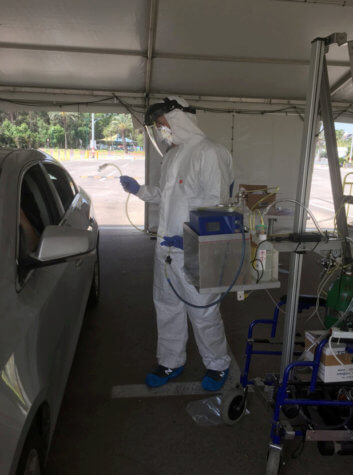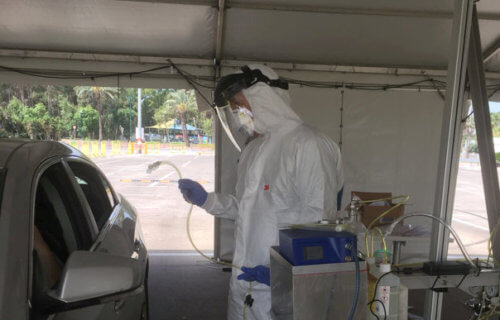REHOVOT, Israel — Since the beginning of the coronavirus pandemic, scientists have been experimenting with training animals to detect the “smell” of COVID-19. Now, a 3D-printed electronic nose may be able to speed up the coronavirus screening process, “sniffing out” COVID in just seconds.
Researchers from the Weizmann Institute of Science in Israel are attempting to perfect the device, which smells chemicals in infected individuals. It may open the door to large-scale testing across the world. Scientists say it could be very useful in airports, offices, factories, and even sporting events.
“The e-nose generates a pattern in every odor – it characterizes the smell of COVID-19,” says project leader Professor Noam Sobel in a release. “We are teaching it to smell coronavirus.”
Rapid diagnosis is key to bringing the pandemic under control, Prof. Sobel adds. The team is hoping their device will enable people to attend mass gatherings and travel by cutting down the waiting time at COVID testing locations.

The instrument, called Pen3, has been trained to identify VOCs (volatile organic compounds) in the inner nasal passage – rather than in a person’s breath. Through experiments involving 503 people, 27 testing positive for COVID-19, results show the electronic nose has an accuracy of up to 94 percent. The team recruited volunteers at a drive-through testing station in Tel Aviv, organized by Israel’s version of the Red Cross.
“Every disease has an odor because they change metabolic processes. Metabolites have a smell,” Prof. Sobel explains.
Instant COVID tests from the seat of your car?
Pen3 – designed to be easily constructed through 3D-printing – has a gas unit and an array of sensors. A sampling valve connects to software that fits snuggly into the nostril. An electric lift on a wheelchair raises it to the level of each patient’s car window. Therefore, people using the system don’t even have to get out of the car.
“When a compound interacts with the sensors, this results in an oxygen exchange that leads to a change in electrical conductivity,” Sobel continues.
Although dogs, which are already a common sight when it comes to airports and other high-security areas, can also use their noses to pick up COVID’s scent, the scale of the crisis makes them an unrealistic option during the pandemic.
“Cars were typically queued up at the testing station. An experimenter in full personal protective equipment (PPE) approached and through a slightly open window explained the purpose,” the study author reports.
“It was a shot in the dark – but the payback will be so huge. We get an answer in 80 seconds. We are obtaining meaningful data.”
The peer-reviewed study in PLOS ONE shows there is a specific COVID “body-odor” that is detectable with Pen3.
“Given our current results an optimized eNose may be able to provide effective real-time diagnoses in locations such as airports, the work-place and cultural events,” Sobel says. “Worldwide, any lab with an e-nose is trying to identify COVID. However, they are testing samples in the lab. We took ours to the field. It could revolutionize COVID testing – producing a diagnosis in about 80 seconds.”
SWNS writer Mark Waghorn contributed to this report.
https://vimeo.com/423217788
